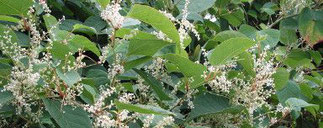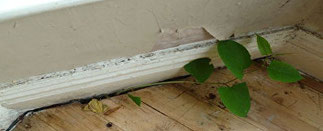Home Contact Rats Bramble Dandelions Knotweed Weeds in Gravel Bindweed Horsetail Slugs Foxes Ivy Leather jackets
What is Japanese Knotweed? how to recognise and identify Knotweed



What is Japanese Knotweed.
- Japanese Knotweed is a very invasive weed, originally brought in from Japan in the nineteenth century as an ornamental plant. It has spread into our countryside and gardens causing
a costly problem. Not just for gardeners, left unchecked, it will invade large areas of land, takeout native plants, break up concrete, block paving ruin clay ponds and canals, damage buildings.
And force the price of your house down. Spreads easily and can regrow rapidly from less than one inch of root.
Out competes our native wild and garden plants.
Very difficult and expensive to control or eradicate.
Can grow through and break-up tarmac and concrete and cause structural damage to properties.
You can be fined up to £2,500 for failing to control Japanese Knotweed.
How to recognise Japanese Knotweed
- It is a non woody stemmed plant that grows up to seven feet high and can grow three feet in a month.
- The stems look like bamboo canes. They can be up to two inches thick and can grow as much as an inch per day.
- The leaves, grow to about to six inches long. They are an ovate shape, pointed at the tip with flattened bases and hairless on underside. See the Japanese Knotweed picture.
- The cream-white flowers grow in panicles from July through to the autumn.
- The root system often extend several yards around and under the base of the plant.
- Roots are quite soft, white maturing to dark brown and knotty. The inside is pale yellow to bright orange with a darker core.
How does Japanese Knotweed spread?
- It spreads mainly through the root system (rhizome) and stem segments. However, can occasionally be spread by seed. Once it has spread under concrete, tarmac or block driveways, Japanese Knotweed causes heave below the surface (pushes surface up) and grows up through the cracks, damaging buildings and roads. Root segments can remain dormant for up to twenty years in soil, before producing new plants, a tiny section can produce a new plant in ten days.
Spreads easily and can regrow rapidly from less than one inch of root.
Out competes our native wild and garden plants.
Very difficult and expensive to control or eradicate.
Can grow through and break-up tarmac and concrete and cause structural damage to properties.
You can be fined up to £2,500 for failing to control Japanese Knotweed.
Proven ways to kill Japanese Knotweed
Use weed Glyphosate weed killer to kill Japanese Knotweed.
My way is to use Glyphosate weed killer.
This is the most effective way to kill and get rid of Japanese Knotweed and it is the method I use. It will require repeated doses to completely get rid of it and may take a few seasons. (The alternative is a complete excavation of the soil discussed below).
I apply it directly to the plant by painting it onto the leaves and the cut end of the stem. The glyphosate is taken in by the plant to the roots (rhizomes) and kills the whole plant and root (rhizomes).
You could try the branded stuff, like Roundup, but it is more expensive and really does not work as well as the undiluted Glyphosate I use.
This is how to use the glyphosate method.
- First cut away the old stems (and burn them) to get at the new growth.
- The best time to apply Glyphosate is in the growing season through to late summer.
- Paint on the Glyphosate when the Japanese knotweed has reached about three feet and apply a second application in mid summer and again in September.
- Check the infestation again the following spring. Glyphosate treated knotweed will sometimes produce small leafed, bushy regrowth about 20 inches in height the following spring. Treat this in the same way.
- This could take up to five seasons. However, if you are vigilante and repeat the above process, as soon as you see new growth, you could get rid of the Japanese knotweed within a lot shorter period.
Always check Strength actually is 360g/l when buying Glyphosate weed-killer from other sources.
2;Digging out the roots (Rhizomes) to kill Japanese Knotweed.
- Remove the complete root system including the tiniest bits..
- Repeatedly destroy the regrowth gradually exhausting the energy reserves in the remaining underground parts however, this could take years.
- If you opt for digging it out the only option to completely get rid of Japanese Knotweed is a major excavation to ensure that any trace of Japanese Knotweed is removed. The problem is this, If even the tiniest fragment of rhizome is left in the soil it will regrow.
- Where will the contaminated soil be dumped.
Japanese Knotweed growing in your garden, can cause major problems, not only to your own garden and property, but to neighbours gardens and properties. In this article, I will explain;
- What Japanese Knotweed is and how to recognise it.
- Actions you can take to kill Japanese knotweed and control the spread.
What does Japanese Knotweed look like
What to do If you have Japanese knotweed in your garden.
What is the law regarding Japanese Knotweed?
The Wildlife and Countryside Act 1981 says, it is an offence to plant or grow Japanese knotweed where there is any risk of causing the plant to spread into the wild or neighbouring properties.
It also states that it is up to you the householder to control the plants from spreading. It is also illegal to dispose of Japanese Knotweed incorrectly, causing further spreading. I have included safe and legal ways of disposal on this page.
If you see Japanese knotweed growing in neighbouring gardens or on council property, try explaining to your neighbour, the potential damage to the countryside and property this will cause if left untreated. If reason fails or you spot Japanese Knotweed growing wild, the police have a wildlife liaison officer who can be contacted.
When I'm treating Japanese Knotweed, I use this Glyphosate, the Strongest Weed killer Available in the U.K. For Uncertified Use. Contains 360 g/l glyphosate. The same as most Professional Grade Herbicides.
One Litre Treats Over 0.4 of an Acre Offering the Best Value
weed killer Available rather than the branded sprays, it is a lot cheaper and a lot more effective. Click the picture for more info.
Always check Strength actually is 360g/l when buying Hi-Aktiv Glyphosate weed-killer from other sources.
Finally a few precautions when dealing with an infestation of Japanese Knotweed.
- Don't use a strimmer, this will spread it.
- If you cut it down dispose of it by burning in your garden. Material taken away must be safely contained and disposed of at a licensed disposal site.
- Digging it up will lead to a significant increase in stem density. Even a tiny bit will start new growth.
- Don't spread soil contaminated bits of root. Any soil that is obtained from ground within 20 feet of it could contain root that is highly regenerative.
- When purchasing locally recycled loose topsoil ask your supplier for a guarantee it does not contain bits of knotweed root.
- Mechanical chippers won't kill it. If you spread the chipped material on soil it will regrow.
- Never add it to your compost heap.
- Don't dispose of Japanese Knotweed at garden waste recycling centres, it will contaminate the compost.
- Don't dump contaminated garden waste in the countryside.
- Don't waste time. If Japanese Knotweed appears in your garden, treat it immediately. Don't allow it to become established.
- Don't break the law. Remember, if you cause Japanese Knotweed to spread you are guilty of an offence under the Wildlife and Countryside Act, 1981.
- Non chemical control. Japanese Knotweed is used to feed animals in some parts of the world, so if you keep goats let them graze the infested area. Grazing will help reduce the spread into uninfected areas and control growth, but will not eradicate the Knotweed. You could of course let the goats do the hard preparation work, leaving only the stems and then follow up with the weed killer treatment.
Latest news about Japanese Knotweed.
People who fail to control the spread of invasive non-native plants such as Japanese Knotweed could be fined or receive anti-social behaviour orders.
The weed is one of the most destructive plants in the UK.
The new rules mean people can now be fined up to £2,500 for failing to control it.
And companies who fall foul of the law can be fined up to £20,000.
The Home Office says these plants threaten the UK's biodiversity by crowding out native species and destabilising riverbanks. They can also do immense harm to forestry, farms, roads and buildings.
Japanese knotweed can grow through tarmac and cause structural damage to properties,
Japanese knotweed is particularly difficult to eradicate. It is very resilient and regrows vigorously after being cut down.
The most effective method of eradicating it is by using glyphosate in the growing season.
How to safely dispose of Japanese Knotweed
- Contact your local council they may offer a collection service or have a list of sites that accept Japanese knotweed waste. If you are going to dispose of the Knotweed yourself, It is irresponsible to dump it anywhere it could regrow, it is also illegal!!
- Bag it. Any plant or soil material to be disposed of off site should be securely bagged to prevent spillage.
- check clothes and shoes making sure no plant or soil material is present. It is easily spread to other parts of yours and neighbours gardens.
- Do not put it on your compost heap or anyone elses for that matter.
- Do not leave it out for the council to collect as recyclable waste.
- Controlled burning is the best and safest way to get rid of Japanese Knotweed.
- Store the green stems and leaves on a ground sheet until they dry out and then burn every bit.

A read for rainy days
In fairy tales, there is always a
Prince Charming and a bad man. Sometimes in real life, Prince Charming is the bad man, or the
bad man turns out to be Prince Charming.
Please be aware, this is not a fairy tale. This book contains references to grooming gangs, sexual abuse, Gaslighting, and punishment of the abusers. Also NON-WOKE scrutiny of British
society.
A dark story of gaslighting, sexual abuse, retribution, and hope. Based on the author's conversations with Willow, a young girl hidden from Society, and with Richard an ex-soldier now working for
a covert agency The Organisation. This book tells how Richard confronts those in authority blocking Willow from the therapy she needs to escape from them and recover, he’s aware of the
consequences. But having ignored evil too often, he’s ready for the risks.
CLICK LINK FOR FREE READ SAMPLE Kindle version Paperback
Writing your first book or novel? This new website provides advice and tips to help write, edit, publish, market and promote it https://www.faircop.com/

